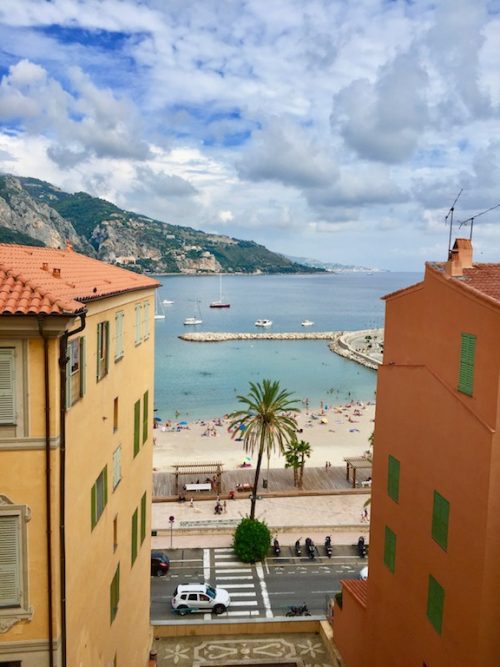By Cheryl Anderson
Although I wouldn’t trade where I now stay, at the top of Cap Martin, I did reside in the vieille ville of Menton for the first nine years I came to the Côte d’Azur. Even now, it’s where I venture most every day. J’adore Menton!
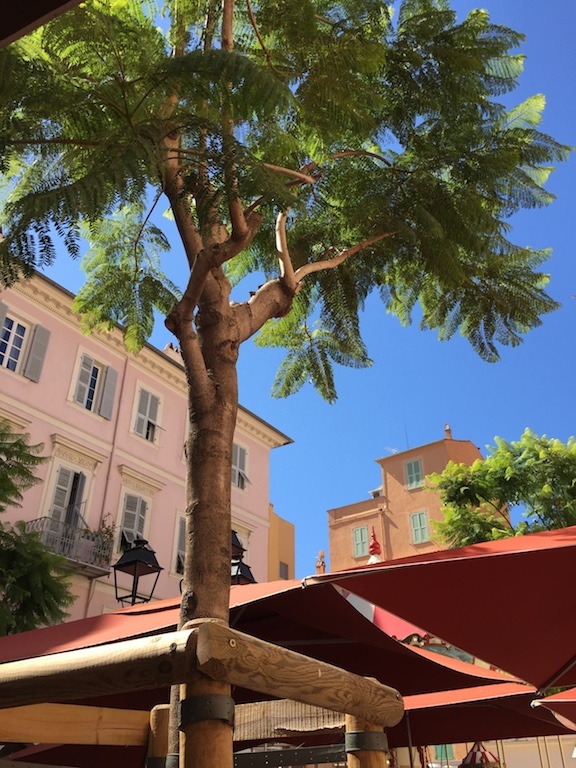
The sky is truly that blue.
Menton is a commune in the Alpes-Maritimes department in the Provence-Alpes-Côte d’Azur region of southeastern France. The word menton means chin. The town of narrow streets first appeared in the 13th century belonging to the Vento family of Genoa until 1346. From there it went to the Grimaldis (Lords) and finally to the Princes of Monaco.
In 1814, Menton was included in a reconstituted principality of Monaco, only to secede in 1848, along with its neighbor, Roquebrune, due in part to a tax imposed on lemon exports. My friends lament that they did so. It’s fortunate to be Monégasque.

Chapelle des Pénitents Blancs.
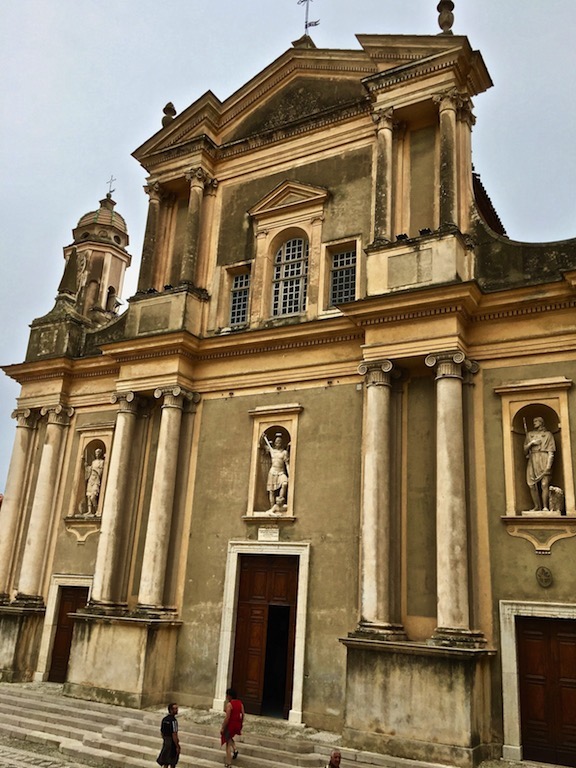
Basilica St-Michel.

Looking up in Basilica St-Michel.
That first year, 1994, my driver dropped me off in front of the Pénitents Blanc church, which is right up the stairs from the St-Michel cathedral. The cathedral has since become a basilica, with remarkable rock designs on the floors of the different squares and stairs. From the square where I was let off, there is a perfectly framed view of the beach, palm trees, and sea; buildings are on three sides of that narrow vista. It was very hot, I was jet lagged, and I was sitting alone on a bench in front of St-Michel, waiting. Even all my angst and the blazing heat did not diminish the feeling of being thrilled to be there and to see that view for the first time. It was like I was hit by a coup de foudre and at that moment, I knew I was meant to be in Menton.
The driver telephoned my contact and very shortly thereafter she was exiting through the archway that leads to the vieille ville. I’m sure she was wondering what I was all about, as was I wondering about her. Her name was Helen and she became a dear friend. Getting to the apartment was no easy trick, pulling luggage over the brick streets that were actually long, deep, and broad inclines going up. The measurement between the steps is the length of a donkey pulling a cart. Tall buildings rose up on either side of the narrow, shaded passage way. I knew I would have a very hard time figuring out the complicated layout of the vieille ville.

First door on the right was mine.
Helen invited me into her apartment, right next to mine, for tea—she was British, after all. Following a little chat, she took me next door. As she opened the tall, shiny green shutters, there suddenly before me was the view of the Méditerranée and Italy. Right outside my window! It was perfect. All of my hopes and expectations had been met with that first glimpse out of my windows.

My first unforgettable, albeit narrow, view of the sea.
The next day I ventured out and learned straight away not to start out too late in the morning as it gets hotter and hotter as the day progresses; it was, in fact, an exceptionally hot summer. I couldn’t wait to get my adventure started. The problem occurred on my way back. I became frightfully lost! I thought I could remember the route I had taken as I left, but the vieille ville and its many pathways all looked alike. After many attempts to find my apartment, I just went back to the St-Michel cathedral and sat down, hoping perhaps my friend would come by. Why I thought that is a curious thing, but I was dangerously hot and could do little else but hope.
I asked many people for direction to my address, but they were of no help. I must have looked very unwell, and I didn’t speak French or Italian. Then an Italian man, bless him, came by. I gave him my address. I guess he could see I was in a real state, so he carefully and patiently gave me directions. I got to the apartment, drank a lot of water, laid down, and woke up the next day. The directions are forever to get back to my apartment: left at the green shutters (they are still green), right at the Madonna (she is still there).
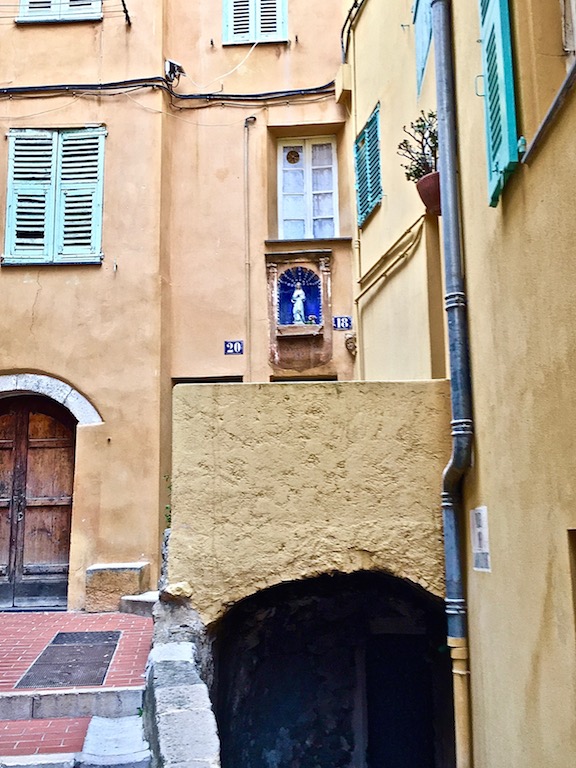
The Madonna where I turned right.
I learned the shortcut to my bus stop, on rue Bonaparte, from my apartment high up in the vieille ville. It was down the steep, dark, and narrow Traverse des Diamants on rue Longue, so named because in the early days, diamonds fell from the jewelry of the royals as they rushed down the narrow passageway to the lower road—much to the delight of the non-royal residents I’m sure. It must have happened often for a traverse to be named marking this bit of its history.

Pergola with cooling mist at L’Esplanade des Sablette.
I know most every nook and cranny of Menton and unless there is a major change in the town or new establishment, I’ve probably been there, shopped there, or eaten there. One very large change, inaugurated in July of this year, is L’Esplanade des Sablette down by the port. It’s broad and long, has some seating under pergolas, some with cooling mist, a few trees, and the beach is at its edge so one can walk right into the water. I see the possibility of many stores to pop up under the arches along the Esplanade. It’s beautiful and such a brilliant addition to the village. Well done, Menton!
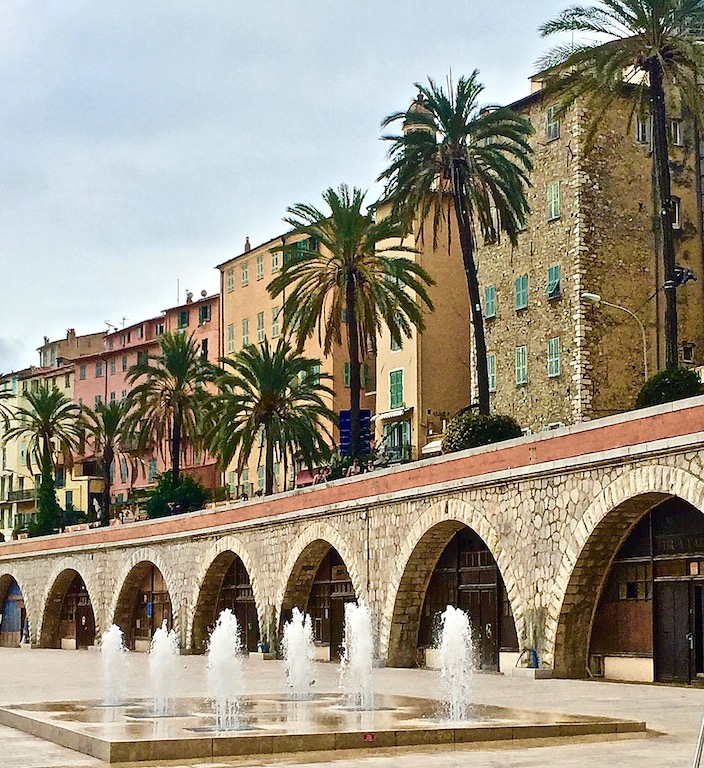
I predict shopping along the Esplanade.
The wide-open plaza in front of the fairly new Cocteau Musée has shaded benches on two sides and a small café that is sometimes open. It’s a nice place to sit and get out of the sun. It’s sort of quiet even though it’s on the street that runs along the seaside of the big, beautiful Marché. The architectural design of the museum was not widely liked according to my friends.
Menton and the citrus limon go together, intricately linked since the 15thcentury; mostly grown by families at that time. In the 16th century, lemons became a commercial enterprise. The climate in Menton is perfect for growing them as they are quite vulnerable to temperature variations, such as frost. Veritable forests of lemon trees began to spring up in the countryside. Stephen Liégeard coined the name Riviera in 1887. He described Menton as “little valleys that relied on the breeze to intoxicate passers-by with the heady fragrance of lemon trees.” The Menton lemon is now a botanical variety.
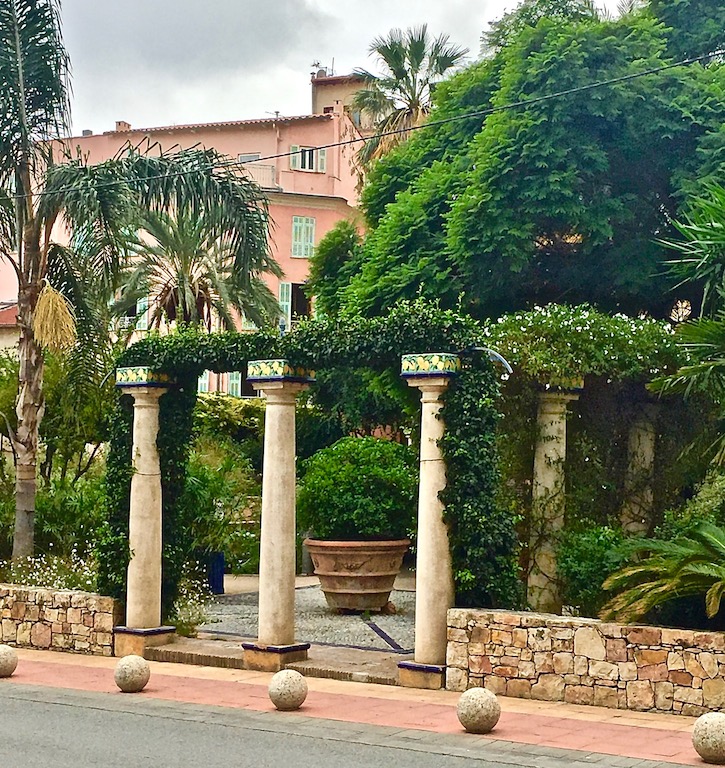
Note the painted lemons at the top of the columns.
Today it’s difficult to find the original Menton lemon species to buy. The Citronneraie is a grove of the Menton lemon and some olive trees; you can make arrangements to visit. What makes them different and sought after by chefs and gourmets is their bright, golden color, a peel rich in essential oil, a thick albedo that holds a great deal of juice in the pulp, and, of course, a fresh, sweet lemony scent.
Every February there’s the Fête du Citron, staged in the Jardins Biovès. It’s much like our rose festival in California, except that here all of the large figures and whatever else are covered in citrus; there’s a different theme each year.
Winter and Spring on the Shores of the Mediterranean (1861) by James Henry Bennett, an English doctor, was impactful on making Menton a destination for those suffering from tuberculosis. Hotels, villas, and palaces were built by English and Russian aristocrats and, during World War I, the residences and hotels were pressed into service to be used for the injured troops to recuperate in a pleasant climate. Menton’s microclimate made it a perfect location. Many of these same hotels, villas, and palaces still exist from way back with, of course, many renovations along the way.

Queen Victoria memorial.
Queen Victoria helped to popularize the Côte d’Azur as a holiday destination for UK residents. She stayed in Menton in 1882. The Queen Victoria Fountain in Place Victoria has a large carving of her coat of arms with a relief of her silhouette at the base of the fountain. Queen Victoria’s granddaughter, Lady Patricia Ramsay, opened the monument on February 21, 1960.
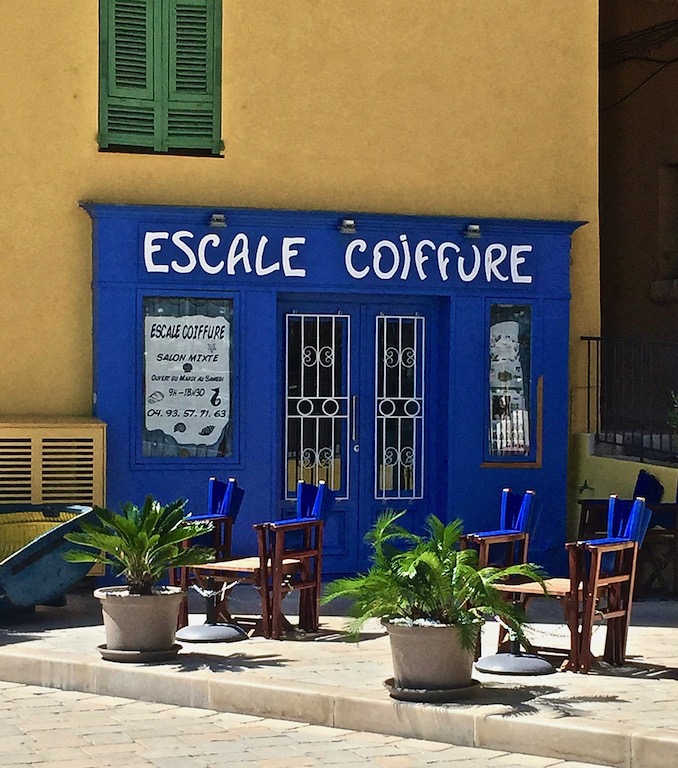
This pretty little shop just makes you want to have your hair done.

A lovely building in town.
I’ve always been struck by the cheerful beauty of Italianate architecture, with buildings painted in bright colors, as well as the belle époque buildings. The towers of La Chapelle des Pénitents Blancs, which faces out to the sea and is up the stairs from the St-Michel square and the Pénitents Noirs on rue de Général Galliéne, rise up above the town making for a beautiful Côte d’Azur skyline.

Towering above the palm trees Pénitents Noirs and Pénitents Blancs.
On the cover of my Baedecker guide to Provence and the Côte d’Azur is the picture of this beautiful skyline. There once was a chateau at the top of the village. It’s long gone, but is now the location of the le Cimetière du Vieux Château. The views from there are breathtaking.

Jardin Méditerranée.
A gas station used to be where now there is the Jardin Méditerranée. I don’t think that’s the official name for the garden, but it’s what my friends call it, and I think the name suits. It’s very lush and pretty with trees, flowers, shrubs, and a fountain that looks like half of a cantaloup. Columns rise up at the Quai Leclerc entrance to the garden. There are other entrances on the town side of the garden.
The garden is a perfect place to sit. I always choose one of the benches in the shade and eat a gelato from Sophia Glacier (the best and freshest!) or a packet of frites from Frites City; both are very close by. The frites are delicious, and the mayo they serve is one of the best choices for a sauce. It’s been there forever and I’ve had my share! Often, it was a stop on my way back up the long trek to my apartment in the vieille ville. Other times I would just sit tucked away on one of the semi-secluded benches in the beautiful setting that is the Méditerranée garden, contemplating how lucky I was, and am, to be there in such a pretty little jardin on the Côte d’Azur.
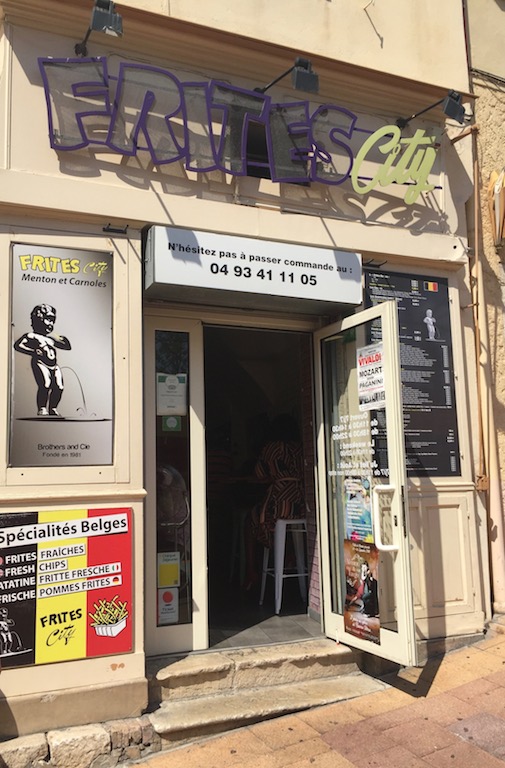
Frites City.
Along the piétonne, rue St Michel, are two of my favorite places. One is the Place aux Herbes, with a fountain in the center. Sitting atop the fountain, is a Mentonnaise with the traditional capeline hat resting on her back. She is forever watching over all who pass by. It is my very favorite statue in Menton and a perfect place because of its central location: “I’ll meet you in the Place aux Herbes.”

Mentonnaise fountain, Place aux Herbes.

Sculpture detail.
The other is the petit palais that belonged to Docteur A. d’Adhémar de Lantagnac, 24 rue Saint-Michel. It’s easy to miss the narrow passageway off of the piétonne leading you into a small courtyard fronting the palais. A pretty iron gate blocks the courtyard when it’s closed to visitors. They have a fantastic collection of books and pottery with the Menton lemon design, manufactured in Moustiers. It’s also where you can sign up for walking tours of gardens and around the town. You can climb the broad staircase inside to the second floor and get a closer look at the paintings on the walls. It truly is a sweet little palais, and I hope someday it will be restored to its former glory.

Adémar Lantenaque petit palais.
Menton’s slogan says it all: Ma ville est un jardin (my town is a garden). Its nickname is perle de la France. Wherever there are trees or bushes or flowers, they are well maintained with care. The streets are always clean, as are the sidewalks.
There are many parks and gardens in town and on the edge of town for you to discover in Menton and seventeen churches to visit. I never knew there were so many. Menton is a friendly, vibrant French village by the sea—and Monaco and Monte Carlo are right now door! It’s my belief you would enjoy visiting. I hope that you will.
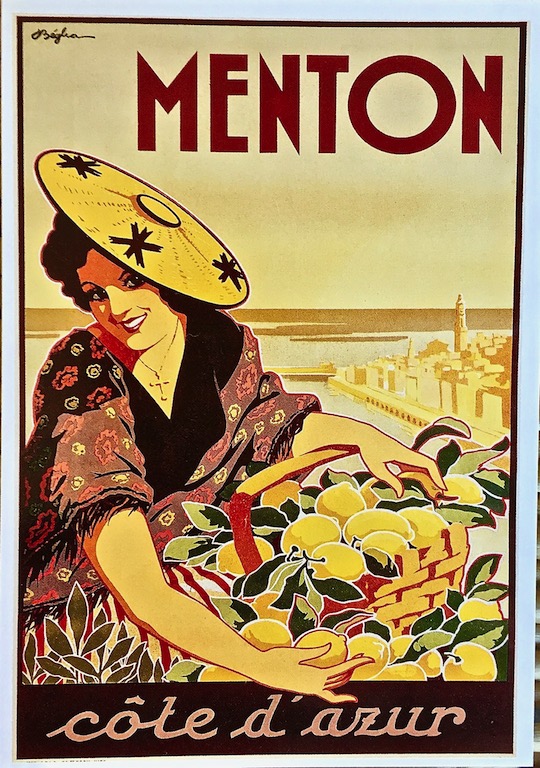
Wish you were here! Postcard of an early l’affiche promoting Menton. A personal favorite to send.
Bonne Vacance!



